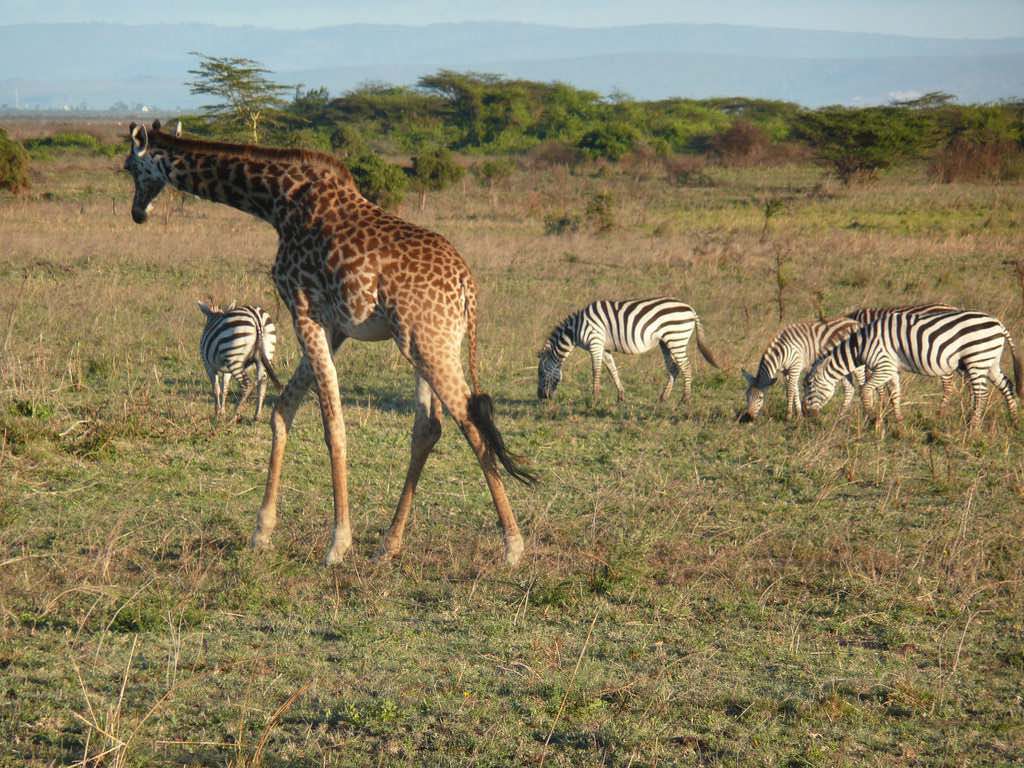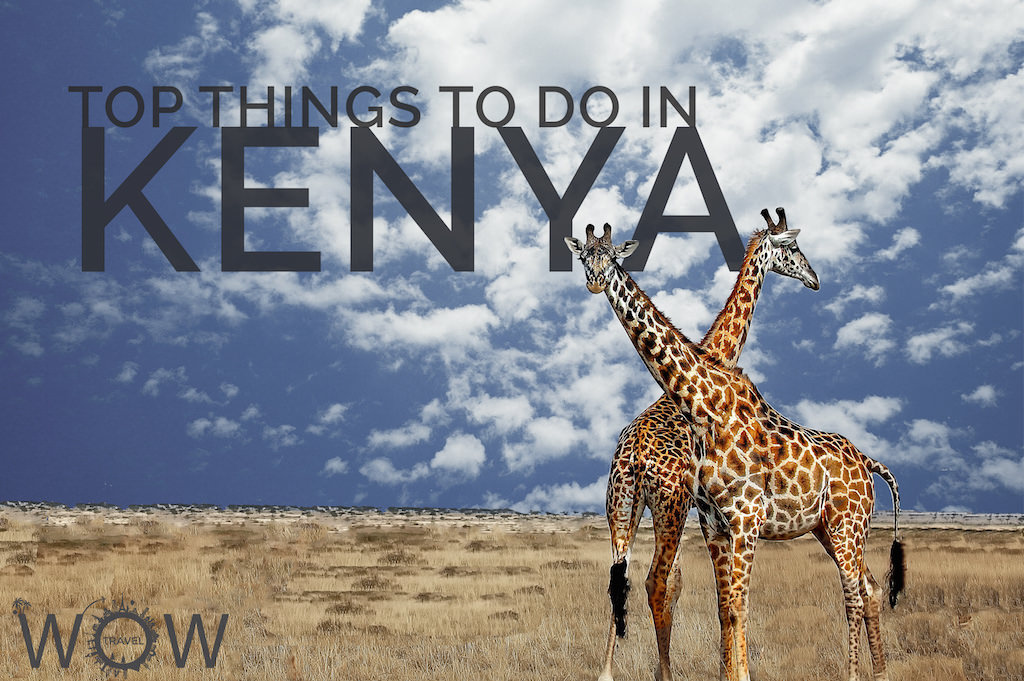Kenya is located in East Africa and is one of the most popular travel destinations in Africa, largely due to its scenery, naturally beautiful landscape with endless savannahs and forests, unchanged culture tribes, white sandy beaches and corals, snow-capped mountains, magnificent wildlife and pleasant year-round climate (Because Kenya straddles the equator, it has up to 13 hours of daylight and consistently warm temperatures year-round). From hand-feeding giraffes to adopting orphaned elephants, taking breathtaking balloon safaris at dawn or trekking and climbing adventures. There is a lot to do in Kenya with its 45 national parks and reserves, not to mention bustling metropolitan cities and towns. WOW Travel shares with you the Top 6 Things To Do In Kenya.
[booking_product_helper shortname=”kenya”]
Nairobi National Park
1
״Nairobi National Park is a unique ecosystem by being the only protected area in the world close to a capital city. The park is located only 7 km (4.3 miles) from Nairobi city center. The savannah ecosystem comprises of different vegetation types. Open grass plains with scattered acacia bush are predominant. The western side has a highland dry forest and a permanent river with a riverine forest. To the south are the Athi-Kapiti Plains and Kitengela migration corridor which are important wildlife dispersal areas during the rainy season. Man-made dams within the park have added a further habitat, favorable to certain species of birds and other aquatic biome. Major wildlife attractions are the Black rhino, lion, leopard, cheetah, hyena, buffaloes, giraffe, zebra, wildebeest, elands and diverse birdlife with over 400 species recorded. Other attractions include the Ivory burning site Monument, Nairobi Safari Walk, the Orphanage and the walking trails at hippo pools.״ Source:KWS


Malindi
2
“Malindi is the second largest town (after its southern neighbor, Mombasa) on the Kenyan coast. The biggest draw for tourists is Malindi’s 96 miles of sandy, palm-shaded beaches, along with the protected coral reefs of Malindi Marine National Park. The sights of the town also reveal the various historic influences of Arab traders, Portuguese explorers, European settlers, Indian immigrants and local customs.” Source: USAToday


Hell’s Gate National Park
3
“Hell’s Gate National Park lies to the south of Lake Naivasha in Kenya, North West of Nairobi. The park which is mainly comprised of savannah ecosystem habours a wide variety of wildlife. There are over 100 species of birds in the park, including vultures, Verreaux’s Eagles, augur buzzard, and swifts. African buffalo, zebra, eland, hartebeest, Thomson’s gazelle, and baboons are also common. The park is also home to klipspringer antelope and Chanler’s mountain reedbuck.” Source: KWS


Lamu Island
4
Nestling against the beautiful, unspoilt Indian Ocean coast of northern Kenya, Lamu Island is one of the most beguiling places on earth. Little changed in centuries, Lamu has long been renowned for the warmth of its welcome to visitors, its remoteness and tranquility, its rich and colorful maritime trading history and its distinctive Swahili culture – a unique amalgam of African, Arabian, Indian and European influences.


Samburu National Reserve
5
Samburu National Reserve lies in the Northern part of Kenya. Count Telekis Companion Von Holnel, visited the area in the early 1860s and described it as teeming with game especially buffalos and rhinos. The Waso Nyiro became renowned early this century as “big game country” and attracted such famous hunters as Arthur Neumann who set up a camp on the site where Samburu lodge now stands. Source: Samburu Council



Mount Kenya
6
Mount Kenya National Park is located to the east of the Great Rift Valley, about 175 km (108 miles) North-East of Nairobi. Far from being a just single peak Mount Kenya is in fact a massif consisting of a multitude of imposing spires, cliffs, complex ridges and peaks. These are the weathered remnants of a large extinct volcano that was active several million years ago. Mount Kenya straddles the equator but is sufficiently high to receive significant snowfall and to be circled with several glaciers. The main summits are the twins Batian and Nelion, and these can only be reached by means of technical climbing via a variety of rock or ice routes. The third highest peak, Point Lenana, is a popular destination for trekking parties. Point John and some of the other subsidiary peaks also offer good rock climbing routes. Source: Summit Post




Just So You Know…
- Kenya shares Lake Victoria, the world’s second largest fresh water lake, with Tanzania and Uganda.
- Kenyans are highly religious people. About 70% of the people in Kenya can be classified as Christians; roughly 25% still adhere to indigenous religions and the remaining 5% comprise of Muslims.
- Kenya has 6 UNESCO World Heritage Sites: Fort Jesus, The Sacred Kaya Forest, Lamu Old Town, Mount Kenya Forest, Lake Turkana, Lake System in the Great Rift Valley.
- Visit the Giraffe Center in Nairobi, it was established in order to protect the endangered Rothschild giraffe, Giraffa camelopardalis rothschildi, that is found only in the grasslands of East Africa.
- Make sure to visit Mara Conservancy, it plays an active role in developing, maintaining, and encouraging conservation efforts within the northwestern sector of the Maasai Mara National Reserve, known as the Mara Triangle.
- Go on a cheese tour – 30 minutes out of Nairobi is the award winning Brown’s Cheese factory. Its product has won many awards. The factory tour shows how the cheese is made, after which guests can settle down to a cheese platter, followed by a three-course lunch complete with homemade chutneys, bread and homegrown salad.
Get Some Culture:
- National Museum – a modern center with a large collection and temporary exhibitions about Kenya’s history, culture, paleontology and art.
- Karen Blixen’s House & Museum – This museum is the farmhouse where author Karen Blixen lived between 1914 and 1931 and wrote her famous memoirs, with original furnishings.
- Railway Museum – Tell the story of the railroad history in Kenya and its impact on the nation’s development.
Grab A Bite:
- Eat in a cave at Ali Barbour’s Cave Restaurant – Ali Barbour’s Cave is thought to be between 120,000 and 180,000 years old. Situated about 30 km (18 miles) south of Mombasa and 200 meters (721 ft) back from the high water mark, it compromises a series of interlinking chambers at depths of up to 10 meters (33 ft) below ground level. The natural holes in the cave ceiling are open to the sky and seating is under the stars creating an intimate and elegant atmosphere. The cuisine is typically international, specializing in seafood.
- Have a dinner at Carnivore Restaurant – This open-air meat specialty restaurant has become a standard stop on the safari trail. Carnivore offers usual fare, such as rumps of beef, legs of lamb, chops, sausages and ribs, but also crocodile, ostrich and chicken livers and gizzards. All roasted on traditional Maasai swords (skewers) over a huge, visually spectacular charcoal pit that dominates the entrance of the restaurant. The waiters then carry these swords around the restaurant, carving unlimited amounts of the prime meats onto sizzling, cast iron plates in front of you.
